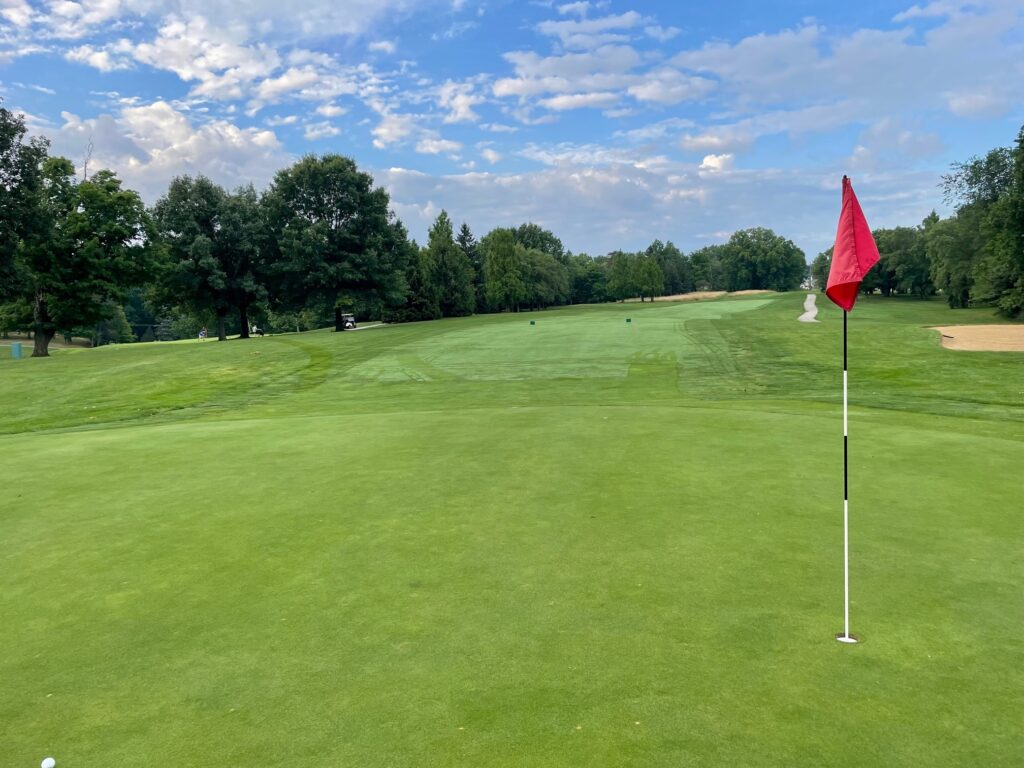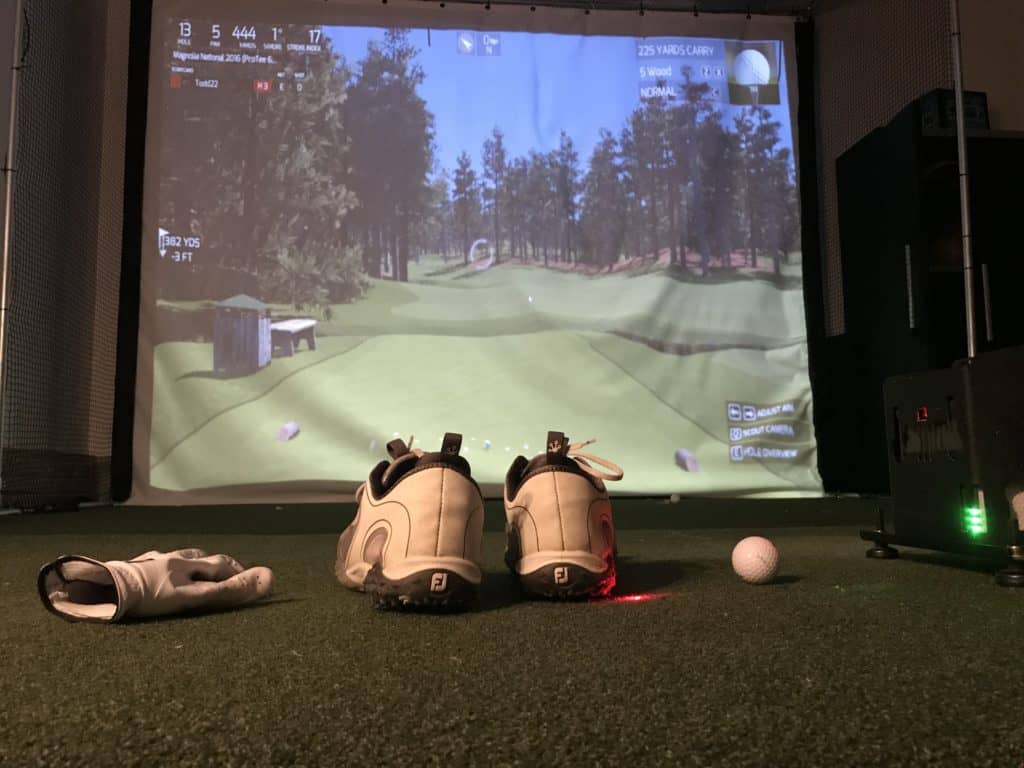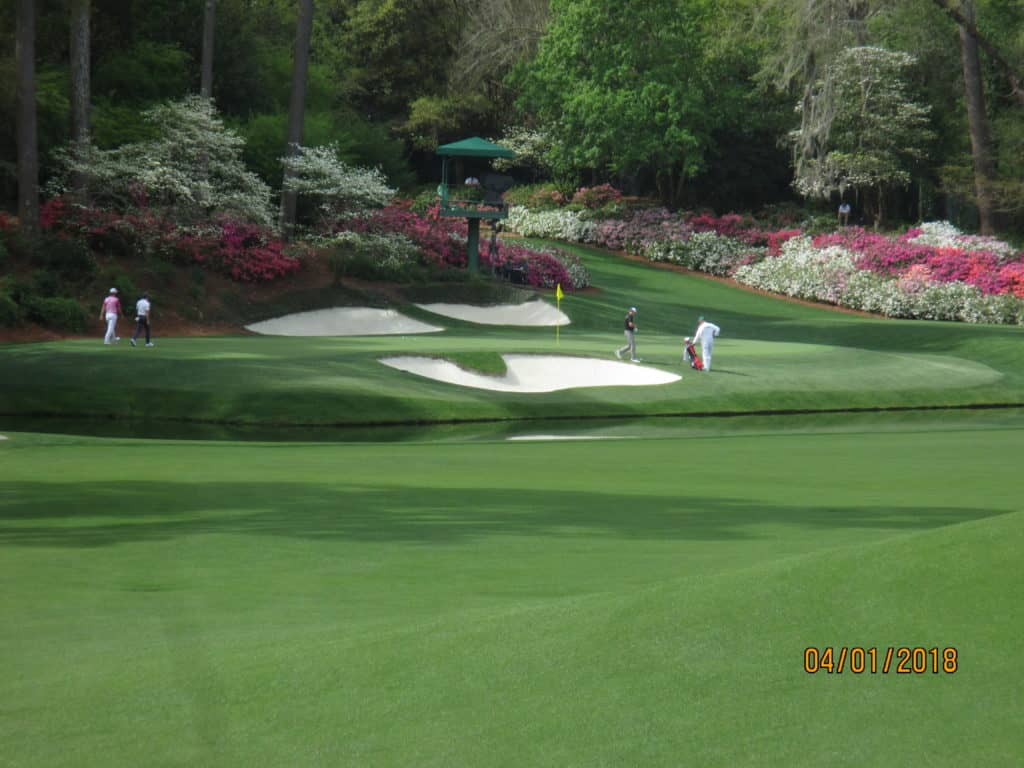Golf can be a humbling game.
One day we feel like we have “found it” the next day we are struggling to even shoot our average score.
Whether it is the driver, irons, wedges or putters causing an issue, the game can be frustrating.
One key for many golfers is that as they learn the game, they can find the causes of some of the worst shots or the shots that creep up at the wrong time. Golfers can then work to improve some of those common mishits and build a swing they can control and execute with for a high percentage of the golf season.
One of these frustrating shots is the pushed wedge shot. It often flies short and to the right and in the worst case situations ends up in a terrible bunker lie.
So, how do we prevent this shot and hit crisp, on the right line wedges shots?
Below, I will get into the causes and solutions of the pushed wedge shot and several of the solutions have some drills you can put in place. These drills can you help with every club in your bag.
The ultimate goal is to develop a wedge game where you can execute and take advantage of the 60-120 yard distance on those short par 4s or the scoreable par 5s!
Why Do I Push My Wedges?
There are several reasons the majority of golfers push their wedge shots:
- Poor alignment
- Hesitant swing
- Lack of a shot pattern
- Poor ball striking

Cause #1: Poor Alignment
Too many golfers really struggle to actually aim where they want to start the ball. They fail to go through a quality pre shot routine to pick a target in the distance, draw an imaginary line back and through the ball and then execute the shot.
This is the easiest of the causes to fix and often doesn’t take swing changes. The problem becomes when a golfer is misaligned and doesn’t realize it and goes on a journey to fix the swing when the real issue was a simple alignment issue.
Solution #1: Use Alignment Stick and Video
Golfers have some great tools right in their hands. They can use club as alignment sticks and video at the driving range to first check for proper alignment. The golfer should start here if they are struggling to hit their wedges on the right line.
Eliminating this potential issue could save you a bunch of time and frustration down the road. Use the alignment stick to ensure proper aim and then take a video from the down the line view to confirm you are aiming where you need to aim.
54 vs 56 degree sand wedge: which one should you use?

Cause #2: Hesitant Swing
Throughout most of the bag, many amateurs are taking full swings with the majority of their iron shots. As soon as they get to that 80 yard wedge shot with a club that would fly 100 with a full swing, they struggle to hit this shot. It can often be caused from the fear of flying it too long or trying to be too perfect. As a result, they slow down through the swing often causing poor contact or a misdirected shot.
How far should you hit a sand wedge?
Solution #2: Develop your 70, 80 and 90% Feels
The key here is to work on the feels or the length of the swing needed to hit different length wedge shots. When you are simply guessing from a lack of development in this area, you are naturally going to be hesitant through the swing. Instead, build these feels and swing with confidence.
I would highly recommend building a chart like this one:
(see below for how to build one of these swing charts)
| Club | Carry Distance (100%) | 90% | 80% | 70% |
| Pitching Wedge | 128 | 118 | 108 | 98 |
| Approach Wedge | 118 | 110 | 102 | 96 |
| SW Club | 105 | 97 | 91 | 85 |
| LW Club | 85 | 76 | 68 | 60 |
How can you create your own chart?
Best Option: I would highly recommend a launch monitor!
These portable devices can be used at the driving range, golf course or set up in your home net or golf simulator. These devices are game changers not only on being able to map your bag and know your distances, but they also provide quality feedback after on every shot and provide the following information:
- Carry Distance
- Spin Rate
- Launch Angle
- Spin Axis
- Total Distance
- Ball Speed
This information will help you map your bag, decide on which clubs are best for your game, develop a stock shot and much more. I love using my SkyTrak 365 days a year in my golf simulator setup.
The process for mapping your bag can looking something like this:
- Hit 5 shots with each club in your bag.
- Log the carry distance and total distance for each shot.
- Eliminate any outlier numbers (poor hits or low spin rates).
- Take the average and create a map of your bag.
If you visit any PGA Tour event you will see plenty of golfers utilizing their launch monitors. While most can’t afford a Trackman, there are some very affordable options in the 500-2000 dollar range. I own the SkyTrak and think the world of it.
How far should you hit a pitching wedge?
Here are the top 3 options to check out:

Cause #3: Lack of a Shot Pattern
Do you hit a draw or a fade with your wedges? Or do you hit both on demand? It doesn’t matter what system you have for your shot partner, but you do need a shot pattern even with your wedges.
Most wedge shots might only curve 3-10 feet, but you should have a shot pattern that allows you to play to the bigger portions of the green. The shot pattern gives you the confidence to make the proper swing without fear or what way the ball is going to curve this time.
Solution #3: Built A Stock Shot
A stock shot is a shot that either draws or fades 90% of the time. Many of the best golfers will play one shot pattern for a high percentage of their shots. This gives the golf confidence in the start line and what way the ball is going to curve. This is my favorite drill to use to keep me sharp throughout the bag.
Stock Shot Drill
- At the driving range, set up an alignment stick about 6-8 yards in front of you, straight down your target line.
- If you have a second alignment stick, set the stick 3-4 feet right of the first stick (for a draw) or left of the first stick (for a fade).
- Complete your initial assessment see how many times out of 10 you can start the ball to the right or left of your target. Pick one side and measure your game at this point.
- The goal is to eventually
Cause #4: Poor Ball Striking
There are a variety of reasons someone might be a poor ball striker:
- Poor low point control
- Lack of confidence in the swing
- Wrong intention with the golf swing
- Lack of time in the game
To play quality golf, the golfer needs to strike the golf ball solid a high percentage of the time. The best golfers strike the ball solid over 99% of the time, while the weakest golfers might not quite do this 50% of the time.
Solution #4: Low Point Control Drill
Regardless of your potential issue above, below is a great drill to help you strike the ball more solid over the coming season.
The Low Point Control Drill
- Take some yard paint and paint a 1-2 yard long line.
- Setup with 55% of your weight on your front side.
- Try to hit the target side of the line and see how many times out of 10 you can do this successfully!
- Repeat this drill every day for a month, tracking your progress and your ability to to this successfully in trials of ten.
- You may need to start with half swing and progress to full swings.
If you are struggling, put more weight forward and work on keeping your head still to help control the low point in the swing.

My Secret To Golf Improvement
Let’s face it, in order to get really good at golf, we must practice frequently. About five years ago, I made the leap and invested in a golf simulator build for my garage. I went with a SkyTrak Launch Monitor and the TGC software and can now play over 100,000 courses including Augusta, Pebble Beach, Bethpage Black, Whistling Straits. St. Andrews and many other of the top 100 courses in the world.
This golf simulator setup, which is more affordable that you might imagine, has been a game changer. I can now play golf everyday of the year regardless of rain, snow, cold weather or time of day. I can practice or play rounds of golf. I can stand in the 11th fairway at Augusta and with the auto-rewind feature I am able to practice my approach shots from various differences.
It is worth checking out through Rain or Shine Golf as they offer some incredible packages along with financing offers that are difficult to beat.
Some direct links to Rain or Shine Golf for pricing and financing:
Take Action – What You Can Do Today to Get Better
What does this mean for you? I believe in the following recipe to get better:
1 – Improve your motion in the golf swing by identifying a golf instructor. Here are some options:
Here is a list of golf instructors that we have reviewed:
2 – Train to swing faster and improve your swing speed. Here are some options:
Looking to gain more Speed and Distance in your swing. Two Options:
3 – Understand course strategy and work to break through your next barrier. Here is a series on breaking through:
We have provided guides on how to break 100, 90, 80 and 70. Check out more below, if interested.
4 – Practice Frequently
Did you know that I build a golf simulator in my garage and have played over 500 rounds of golf on my SkyTrak system? It has been a game changer and one worth checking out. Here are some of my other posts on golf simulators frequently asked questions:
- Is a Golf Simulator Worth It?
- How to Build a Golf Simulator?
- What is the Best Golf Simulator?
- Golf Simulator Accessories?
- How to Build a Golf Simulator for under $7000
- Top 11 Reasons to Buy a SkyTrak
- How to Build a Golf Simulator for Under $1000
- Why Build A Golf Simulator?
- What Space is Needed?
- Can A Golf Simulator Improve My Game?
- How Much Does A Golf Simulator Cost?
- Don’t Forget to Check out our 15 best golf swings of all time.
I am an amateur golfer on a journey to get better, enjoy the game as often as possible and share my passion and knowledge with others. I have coached high school golfers at a high level and have a great passion for the game and want to give back. I enjoy learning about the golf swing and am currently studying to be a certified professional golf instructor. Join me in our journey to get better everyday. Thank you for reading!

